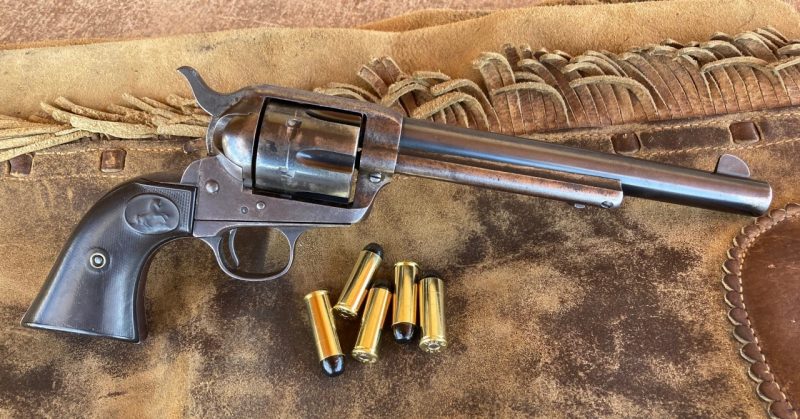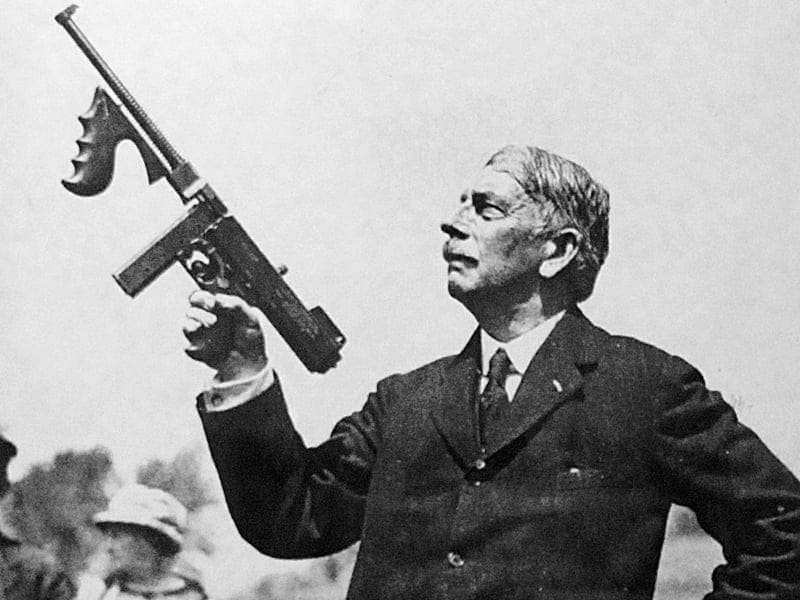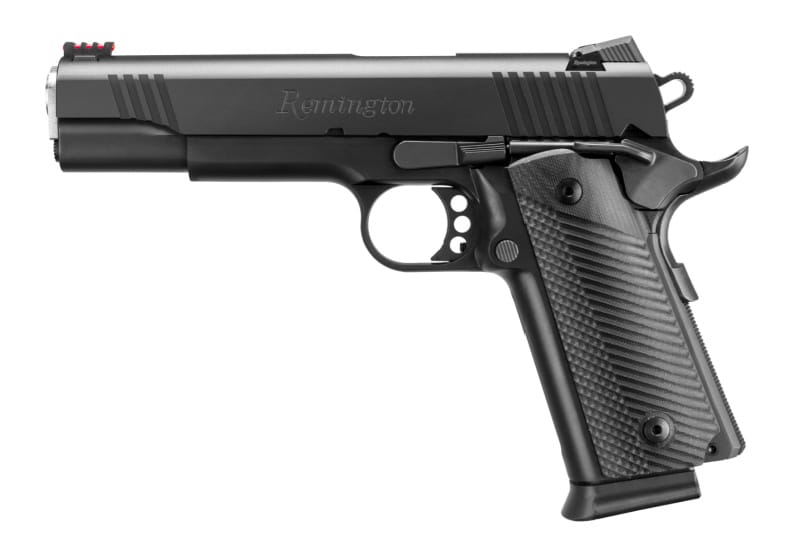If I had a nickel for every time I read about stopping power and the .45 ACP, I’d have at least $100. According to all the gun rags I read when I was a kid, it was the ultimate man-stopper, especially when it was fired from the M1911. Does the .45 ACP possess this power to just knock ’em down? That’s an interesting question, and I think we should dispel some mysticism from the weapon. To dispel this mysticism, we have to travel back in time, way back, to the Philippine Insurrection.
The .45 and the Phillippine-American War
In 1899, an American expeditionary unit was sent to the Phillippines to suppress an insurrection. Spain ceded the colony to the United States, but no one seemed to ask the Filipinos. Thus, an insurrection occurred. Let’s not dive too deep into the politics of the war or the effects, but instead, let’s focus on the Colt M1892 carried by American forces.
The Colt M1892 was the American sidearm of the era. It was a double-action revolver with a side-opening cylinder that fired the .38 Long Colt cartridge. The .38 Long Colt was a black powder cartridge with a power equivalent to that of the modern .380 ACP. Fighting in the insurrection was brutal and bloody. The Moror tribesmen would often ambush American forces at extremely close ranges, often armed with melee weapons.

This close quarter’s fighting meant revolvers were used fairly often compared to other wars and battles. Troops fighting in the Philippines reported that the .38 Long Colt wasn’t stopping the enemy. They would shoot the Moro tribesmen, and the Moros would keep fighting. Colonel Lous LaGarde reported an instance of the round failing. According to his report, the following occurred.
“Antonio Caspi, a prisoner on the island of Samar, P.I. attempted escape on Oct. 26, 1905. He was shot four times at close range in a hand-to-hand encounter by a .38 Colt’s revolver loaded with U.S. Army regulation ammunition. He was finally stunned by a blow on the forehead from the butt end of a Springfield carbine.”
LaGarde reported that the prisoner was shot three times in the lungs. That was good shooting. The failure of the .38 Long Colt caused the military to pull out the classic .45 Long Colt and Colt Single-Action Army.
The Quest for the .45
The insurrection ended in 1902. The concern regarding the .38 Long Colt continued, and the Army decided they wanted to do a number of tests to determine the best option for a military handgun. The Army paired the aforementioned Colonel LaGarde with Infantry Major John Thompson. Yes, the same Thompson who invented the Thompson submachine gun.
The Thompson-Lagarde tests began in 1904. The tests were conducted at the Nelson Morris Company Union Stockyards in Chicago. The tests involved live cattle bound for the slaughterhouse, human cadavers, and a few dead horses.

The test cartridges included the .38 Long Colt, the .38 ACP, the .45 Long Colt, the .476 Eley, the .455 Webley, the 9mm Parabellum, and the 7.65x21mm cartridge. The testing involved shooting live cattle and recording the effects. The tests took two days, and the board reported their results.
“the Board was of the opinion that a bullet, which will have the shock effect and stopping effect at short ranges necessary for a military pistol or revolver, should have a caliber not less than .45.”
Cows Aren’t People
Since then, these tests have been subject to a fair amount of ridicule. They weren’t particularly scientific. One of the tests was to hang a human body and measure how much the body swayed when a projectile struck it. When shooting the live cattle, there seemed to be very little control to ensure the tests were similar between each caliber. Reading the reports seems to suggest that they just shot animals ten times and recorded the effects.
It’s worth noting a cow does not make a good stand-in for a human. I’m not sure if you’ve ever seen one, but they tend to be bigger than people, with much different bone density, muscle mass, and fat distribution.

The .45 caliber rounds performed better since they used revolvers with hollow points and soft lead rounds. These tend to mushroom and create a greater degree of damage. Most of the other cartridges used jacketed bullets, which would zip through a target. At a glance, it seemed like Thompson and Lagarde made their decision before the beginning of the tests. They then ensured their chosen caliber used the right ammo to generate the desired effect.
The Next Service Pistols
The Army adopted the Colt New Service in the .45 Colt and later adopted the M1911 in the .45 ACP. This move began this American-oriented theme of thinking bigger is always better. If you’ve ever wondered why guns like the LCP used .380 instead of something more sensible,
like .32 ACP, it’s because the American bigger is better mentality.
The Truth About Stopping Power
This idea of stopping power became mainstream. Your gun needs enough stopping power, or it’s useless, the gun rags proclaimed. However, no one explained how stopping power worked in stopping the threat in regards to handguns. Plenty of people tried to explain stopping power using energy, bullet size, and the like. Still, I’ve never seen a single formula that explains how its energy, foot pounds, and bullet size relate to a handgun’s ability to stop a threat.
Rifles are a bit different. Rifle projectiles are moving insanely fast. A rifle round wounds in two different ways. First, we have the round’s direct contact with the flesh in front of it. That’s the simplest method of injury. The speed of the rifle round also creates a massive temporary wound cavity that can expand up to 12.5 times the size of the projectile. This ‘shockwave’ can devastate internal organs and flesh.

A handgun only has one wounding characteristic, and that’s the direct path of the projectile hitting flesh. Handgun rounds cannot generate massive shockwaves that do permanent damage. While a bigger bullet, like the .45 ACP, creates a bigger hole, the size difference is just a few millimeters.
A handgun round can only stop a target by hitting something vital. Shots to the heart, brain, lungs, and spine tend to stop targets very quickly and effectively. When we come down to hitting the vitals, the minor differences in the sizes of projectiles don’t make that much of a difference. Heck, even the speed of super-fast handgun rounds doesn’t make a big difference.
Handguns and Stopping Threats
To stop a threat, a handgun projectile must penetrate deep enough to reach something important. As mentioned, the heart, lungs, and brain are our prime targets. The spine works, but that’s tough to hit. We don’t necessarily need a big bullet, but we need a bullet that can reach the vitals. Most modern handgun rounds can do that. With that said, you might want a hollow point to make a bigger wound channel while using a smaller projectile.

There are numerous reasons to use JHPs, including overpenetration and creating a bigger wound channel. When it comes to caliber selection, you typically want to find a round that can penetrate, and you can shoot well. Low recoil and a higher capacity can be much more beneficial than a bigger bullet and lower capacity.
What Matters With Handguns
The .45 ACP served for decades with the M1911 until 1985, when the Beretta M9 was adopted. The United States finally standardized on the same round Europe has used for decades. The M9 packed more than double the ammo and was easier to shoot with lighter recoil. Since then, the 9mm has been the standard and will seemingly remain the standard.
The idea that .45 ACP offers some kind of magic stopping power that makes it much more effective than any other round is a myth. It’s why the cartridge has slowly faded away with professional shooters. Handguns, as a rule, suck at fighting, and accuracy is critical when using a handgun. While the .45 ACP can be very effective, so can the 9mm, .380, .38 Special, and many more.

